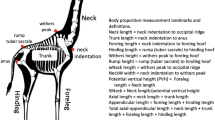Abstract
According to the specimens of ulna-radius of the Cape Hare (Lepus capensie) shot in fall and winter in Shanxi province, China, the ossifications of epiphyses cartilage of ulna-radius are divided into 4 stages. With weight of eye lens as a reference, it is proved that the age criterion could be used to distinguish young less than 6–7 months old from those older. This is a pragmatic method to analyze age composition of game-bag in the early period of shooting season when younger holds a large proportion in the hare population. It also is useful in judging the age of hares trapped and estimating the effects of predation on the hare population structure.
Similar content being viewed by others
References
Broekhuizen S, Maaskamp F. Age determination in the European hare (Lepus europaeua Pallas) in the Netherlands.Z Saugetierk, 1979,44: 162–175.
Chapman J A, Flux J E C (eds).Rabbits, Hares and Pikas: Status Survey and Conservation Action Plan, Gland: IUCN, 1990.
Lu X, Guo D L. Present situation in studies on hares population ecology.J Shanxi Univ, 1992,15(2): 206–213
Lu X, Shen S Y, Gao S W. Determination of age and analysis of population structure in Cape Hare (Lepus capensis).Acta Theiol Sin, 1994,14(3): 176–183
Lu X. 1995 Studies on breeding biology of the Care Hare (Lepus capensis).Acta Theriol Sin,15(2): 122–127
Lu X, Shen S Y, Gao S W. Some ecological aspects of the Cape Hare (Lepus capensis) in Shanxi province China.Chinese J Zool, 1995,30(2): 50–53
Andersen J, Jensen D. Studies on the European hare XXVIII: The weight of the eye in European hares of known age.Acta Theriol, 1972,17(8): 87–92
Keith L B, Cary J R. Eye lens weights from free-living adult snowshoe hares of known age.J Wildl Magmt, 1979,43: 965–969
Pepin D. Variation in survival of Brown hare (Lepus eruopaeus) leverets from different farmland areas in the Paris basin.J Appl Ecol, 1989,26: 13–23
Pepin D. Dynamics of heavily exploited population of brown hare in a large-scale farming area.J Appl Ecol, 1987,24: 725–734
Andersen J. Some studies on hare populations.Danish Rev Game Biol, 1958,3: 70–71
Walhovd H. Reliability of age criteria for Danish hares (Lepus eropaeus Pallas).Danish Rev Game Biol, 1966,4: 106–128
Broekhuizen S. Age determination and age composition of hare populations.Intern Union Biol X Congres, Paris, 1971, 477–489
Broekhuizen S, Maaskamp F. Annual production of young in European hares (Lepus europaeus) in the Netherlands.J Zool Lond, 1981,193: 449–516
Author information
Authors and Affiliations
Additional information
Supported by the Natural Science Foundation of Shanxi Province
Lu Xin: born in 1963. PhD
Rights and permissions
About this article
Cite this article
Xin, L. Determining the age of the Cape Hare (Lepus capensis) by the ossification features of epiphyses cartilage of ulna-radius. Wuhan Univ. J. Nat. Sci. 3, 481–484 (1998). https://doi.org/10.1007/BF02830056
Received:
Issue Date:
DOI: https://doi.org/10.1007/BF02830056




